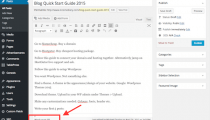
Creating a Successful Blog Post – From Idea to Promotion
Some people think blogging is as simple as thinking up a great idea, punching out a couple hundred words, publishing it, tweeting about it, and then being done with it. Others think blogging is a complex activity that is reserved for those who have some kind of gift. The reality is, it is something in between. It’s about ideas, processes, and strategy. It’s about being passionate about a particular topic. It’s about the synergy of taking what is in your head and translating it to make sense to the masses.
So how do you create a blog post? And not just any blog post, but a successful one? It’s about having a plan, from idea to promotion and everything in between. Here is my blog post-process in stages.
How To Create a Successful Blog Post – From Idea to Promotion
Ideas hit me all the time – they happen offline when I’m at a conference (for example I will have a TON of ideas during Blog World sessions guaranteed), driving, shopping, or even playing with my dog. They happen online while I’m perusing Google Reader subscriptions, reading other people’s posts, making blog comments, or watching my Twitter list feeds whizz on by.
To make your idea stage as beneficial as possible, you have to make sure that you don’t lose any of those great ideas, whether they are ones that you want to start writing about the moment they pop into your head to ones that you might not actually tackle for another couple of weeks, maybe even months. So whenever you get a great idea, keep track of it – write it on a sticky, send yourself an email, record it by voice on your iPhone… whatever it takes to make sure the idea doesn’t get lost somewhere in your mind never to resurface again.
The key to making your idea stage manageable (especially if you have a lot of rogue ideas that come into your mind all of the time) is to take all of those ideas and get them into one place. My personal favorite tool as you might guess from my previous posts here on affiliate marketing organization and measuring blog growth) is a Google Docs spreadsheet. This spreadsheet has four simple columns:
- Category – mine usually blogging, social media, SEO, photography, or business.
- Site – for some titles, I usually try to fit it to one of my own blogs or ones I regularly contribute to.
- Title – the great headline idea.
- Notes – miscellaneous information that will help me when I get to actually writing the post.
The beauty of this spreadsheet is that I now have over 70 ideas ready to go when I need them, and I can easily use the filters to look at them by subject or by the site I need to write for. That little bank of ideas has come in handy, especially for blog contests. I have won two so far using topic ideas I had thought about over six months before the contest. I like to think that I was subconsciously saving them for something special, and my mind knew that the contests were the right time to unleash them.
How To Create a Successful Blog Post: The Writing Stage
Now, the time has come when I need to take one of my roaming ideas and make it into a real, live blog post. This part is usually a fluid process for me – sometimes I start by just writing out everything, then organizing it into logical sections after the fact. Other times I will start with a clear outline of header points and then fill in the information as applicable. I like to leave things a bit unstructured during this stage because I like the possibility of having a new idea pop up in the middle which either takes the post in a new direction or gets added to my idea list for another post.
One thing I have found is key during the writing stage is to not let any distractions get in the way, and one of the biggest distractions I have found is obsessing about grammar and spelling. Of course, this lack of obsession has led to little oopses here and there in my posts, but I find that when I stop because Microsoft Word has highlighted a bunch of misspellings, I lose my writing rhythm – my mojo, so to speak. So I write in WordPad which doesn’t do any kind of checks, then copy the post into Microsoft Word for the editing portion.
How To Create a Successful Blog Post: The SEO Stage
Notice I didn’t think about search optimization until now. People (especially SEO’s) may disagree with this, but I find that if you’re not thinking about optimization, you’re fully focused on producing content that people will love to read. If you’re focused on how many keywords you can stuff in your header tags, the title, and throughout the content, you take away from the reader’s experience.
This is why I wait until after the post is complete to work on some optimization. I take that title I generated during the idea process and look at it to see what kind of keyword phrases would go best. In a recent post on my site, the post was about (and originally titled) comparing DIYthemes’ Thesis Framework to StudioPress’ Genesis Framework. Now I could have spent the first chunk of my time figuring out better titles, meta descriptions, keywords, etc. and then wrote the post, but I chose to write the post instead.
Once the post was done, I went over to the Google AdWords Keyword Tool and started popping in variations of Thesis, Genesis, premium WordPress themes, and so on. And thus was born Thesis vs Genesis – Comparing Premium WordPress Themes. From there, I formulated the meta description, other keywords, trickled through the headers for a bit of tweaking, and voila. Now my post that was constructed purely for reader satisfaction was also made to be SEO friendly.
Creating a Successful Blog Post: The Publishing Stage
Wait, isn’t writing and optimizing the post the same as publishing? Nah. I consider some crucial elements during the publishing stage to happen after the writing, editing, and optimizing is done, but before you actually press the publish (or schedule) button.
One thing you want to do during the publishing stage ensures your post has some kind of call to action. Think about what you want people to do once they’ve read the post – do you want them to purchase a product with your affiliate link, leave a comment, share it on Twitter, read about your services, and/or buy your eBook. If you want people to do something, you need to make sure your post has links to the affiliate products, a question at the end asking people for their opinions, a social sharing button (or a ClicktoTweet link for sites you have no control over their sharing buttons), a lead-in that leads the reader to want your services, and/or a reason that people should logically continue on to check out your eBook.
After establishing your calls to action, you want to ensure that, at the very least, people don’t just leave your post once they’ve finished reading. The way to ensure this is by having some good internal links throughout your content and at the end of the post in the form of Related Posts (WordPress makes a great plugin for related posts too). Internal links might get readers attention as their going along – hopefully they will open them in a new tab and save them for continued reading, and related posts might take them somewhere else on your site right as they might have been considering moving on to another site.
Other great reasons to add internal links include getting a link back from sites that steal your content (because hey, it’s going to happen – might as well get some value out of it right) and getting a handy trackback alert to sites stealing your content since they’ll be inadvertently linking back to your posts. I’ve found many a thieving website using this tactic.
Last but not least during the publishing stage is deciding when to actually publish your post. Did you write an amazing post on a Saturday? Then you definitely don’t want to hit the publish button – think about a day during the week that will likely bring you more traffic (I prefer Mondays and Tuesdays for the best posts) and schedule it then. Also consider, for those of you in Triberr or those who have a lot of people automatically tweeting your posts when it goes live, the time you are planning to publish. You want all of those tweets to be seen by your target audience as opposed to going out at 2:30 in the morning when your time zone is fast asleep. I have found 9 AM EST best to get the most social sharing and 12 AM PST best for getting the most comments. More commenters are insomniacs I guess.
The Promotion Stage
This, I must admit, is probably my favorite part of blogging. While awesome content is the only thing that will make you go viral, awesome content will never actually go viral if no one sees it. So unless the world comes to your blog on a daily basis without any incentive, you’re probably going to have to go tell the world about your post through blog post promotion.
I have different “levels” of post-promotion processes. I don’t think you bring out the big guns for every post you publish – unless you only publish once a week and every post is 100% gold-certified awesome. I, for example, have several posts a week that go live between my site and the others I write for. Although you may your heart into every post, you know which ones are killer awesome and which ones are averagely awesome.
For averagely awesome posts, my post promotion process includes:
- Tweeting the post from my account, usually just once between 7 AM PST and 11 AM PST.
- Sharing it on Facebook, LinkedIn, OR Google+, but not all three.
For awesome posts (once a week), my post promotion process includes all of the above plus:
- Sharing it on two out of three networks between Facebook, LinkedIn, and Google+.
- Sharing it with my followers on StumbleUpon (not a quick process as I have almost a thousand and I have found that you have to share in small groups in order for the share to actually work correctly and send to everyone).
- Give it an extra tweet, later in the evening or the next day that it goes live.
- Inclusion in my writing portfolio.
- Inclusion in my custom RSS feed for Triberr, Blog Engage, and other social site submission.
For killer awesome posts, my post promotion process includes all of the above plus:
- Sharing it on all three networks between Facebook, LinkedIn, and Google+.
- Sharing it in groups on Facebook and LinkedIn.
- Multiple tweets with re-worked titles over the course of the next week.
- Blog commenting promotion.
- Direct messaging some partners in social media to see if they’ll help spread the word.
Promotion can take anywhere from a few minutes to a few hours, and then some over the course of the next few days. If you’re entering a blogging contest, you have to step that up ten-fold to ensure you have the most social votes possible to win. And of course, your social promotion isn’t going anywhere if you haven’t built up a good audience, so you have to lay a good foundation before you can have a successful blog post promotion execution.
What is Your Blog Post Creation Process?
That’s the nuts and bolts of my process, from the birth of an idea to the maturation of its promotion. Now it’s your turn – what is your process? What do you find most successful? Please share your thoughts in the comments, and share this post on Twitter for fellow bloggers looking to improve their blog posting skills!













Hi Kristi
I found the ‘promotion stage’ very interesting. I haven’t relly been online very long and am still learning, but hadn’t really thought of ‘promoting’ a post. I belong to a form where we post our latest blog.
I can see that I have a lot of work still to do!
Thank you for an educating post.
Dee
It’s ok Dee. I started out doing very little in the way of promotion, then I went through a phase where I was convinced self-promotion was a bad thing, and then I finally realized if you should be proud enough of your content to stand on the rooftops and shout about it! 🙂
Hi Kristi,
Great article, I didn’t know about Triberr. Does the site produce good traffic for you?
Thanks DT. I haven’t been on it long enough to know if the Triberr tweets themselves are driving traffic, but the inside stats show that my posts are getting a minimum of 200 views just from those tweets, so that’s pretty impressive. I plan on doing a more in-depth look at it in the near future.
Why don’t you promote your blogpost on all 3 social media?
It’s a personal preference Remco. I always post it to Twitter, and then I choose one out of three between Facebook, LinkedIn, and Google+ because I figure the same people are probably following me on most of those networks. But when it comes to that killer post, I’ll do all the networks I can get it moving on!
Kristi,
Great cradle to grave synopsis of what to do for a blog post. There really are a lot of steps to the process to ensure that it is successful.
I absolutely agree with you on the SEO coming AFTER the content (although I do not make claims of being an SEO “expert”). I think writing the content with only the thoughts of pleasing the reader first and THEN trying to make it work for SEO seems the way to do it.
Killer content (like this post) really is and should be the goal.
That’s definitely the goal for me Steve. I also find that the SEO works itself out – an article that is reader friendly is more likely to be shared socially, and the more it’s shared, the more people that might link to it. And links are definitely good for rankings!
Great post. I didn’t realize just how many other steps I could take to maximize the promotion of my blog posts. Great info!
Thanks! There’s definitely a lot you can do to ensure your post spreads well on the social web!
A really great read that is appreciated, it will certainly make sure I change my strategy.
Glad it helped Bryn! 🙂
Great post Kristi, I really like your idea of doing SEO after the writing stage. I always do my keyword research before I write blog posts and it seems to take me FOREVER. I am going to try your method and I will let you know how it goes. I think that getting my writing down first will help me with ideas for keyword research. Thanks again!
You have to find the method that works best Thomas. I find that it’s harder to look at keywords and come up with a topic vs. come up with a topic, flesh it out, and then let the keywords selection develop naturally throughout the post. 🙂
awesome article….learn about the thesis stuff!
Thanks Deva! Hope you like that post on the Thesis vs Genesis!
Seeing how kickass your posts are, it’s no surprise that you follow such a sexy, in-depth blogging strategy Kristi.
It’s easy to tell the difference between a post that’s been written and shot off in 30 min and one that took hours to create. That’s why I say ‘write’ vs ‘create’!
They both have their place, and for anyone wanting to know how to create really valuable, killer content, your process is tops.
I have a similar process, except I never spent enough time doing SEO (or writing epic posts). I’m changing that though. Thanks for the great post. You rock!
I think the fastest I’ve ever written a post was 45 minutes, and it was one of those opinionated posts vs. tutorial style ones. I think on average, I take about an hour and a half, with some posts breaking into a few hours a day over the course of a few days. But those posts are usually the golden ones! Thanks Tia! 🙂
Michael believe it or not. I came up with a blogging idea while at Jury Duty today.
I’ve been there Matt. I just wished I could have had a notepad with me during mine. Thank goodness the trial ended without a jury decision – not sure I could concentrate on that case anyway.
a blog takes a lot of promotion and stuff to be successful. It simply isnt a short term success.
Definitely not Fazal. You have to keep up with great content and promotion consistently for long term success!
Thank you Kristi! Your post provided some great insight into post writing. I got a few golden nuggets from that.
i have been following income diary for like ages. The new person known as Kristi can maintain the good useful article. I am clear now about the promoting my blog 🙂
Hey Kristi you have opened my eyes….some say I have a great blog but I didn’t see any increase in my traffic. Many thanks for helping me.
Hello Kristi ……i am really surprised by this awesome post…… Plz give me your facebook profile id….i wants to talk with you about so many problems ….about my website…… Please help me out…
Thanks kristi your post is very informative I hope I can really apply this in my post. T
Very informative post. I especially liked the part about not SEO’ing until after writing post. It ensures that you are concentrating on writing good content.
Yes, this is the blog and thanks for sharing your excel sheet for topics and ideas. I kept getting these good ideas but then before I could write I was losing them them!